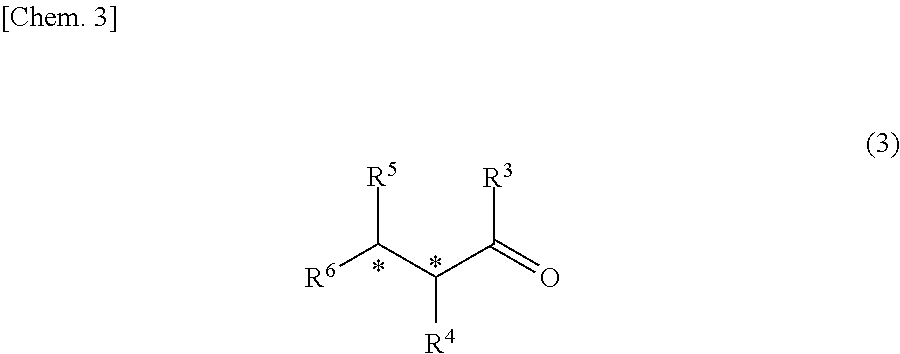Catalyst for asymmetric hydrogenation
- Summary
- Abstract
- Description
- Claims
- Application Information
AI Technical Summary
Benefits of technology
Problems solved by technology
Method used
Image
Examples
synthesis example 1
Synthesis of (R)-proline-N-ethyl carbamate methyl ester
[0162]
[0163]This was carried out in accordance with the synthesis method of Tetrahedron, Vol. 49, No. 23, 5127-5132.
[0164]A 35.54 g (0.3 mol) portion of (R)-proline, 600 ml of anhydrous methanol and 41.46 g of potassium carbonate were put into a 2 liter capacity four neck flask, followed by stirring. Under ice-cooling, 71.62 g (0.66 mmol) of ethyl chlorocarbonate was added dropwise thereto at 25° C. or less, followed by stirring at 0° C. for 12 hours. Thereafter, methanol was evaporated, the residue was mixed with 300 ml of water and extracted with 450 ml of chloroform, and the water layer was further extracted twice with 450 ml of chloroform. The thus obtained organic layer was washed with saturated brine, dried with anhydrous magnesium sulfate and filtered, and then the solvent was evaporated to obtain 52.85 g of the product of interest with a yield of 87.5%.
synthesis example 2
Synthesis of (S)-proline-N-ethyl carbamate methyl ester
[0165]
[0166]This was carried out in accordance with the synthesis method of Tetrahedron, Vol. 49, No. 23, 5127-5132.
[0167]A 23.03 g (0.2 mol) portion of (S)-proline, 400 ml of anhydrous methanol and 27.64 g of potassium carbonate were put into a 1 liter capacity four neck flask, followed by stirring. Under ice-cooling, 47.75 g (0.44 mmol) of ethyl chlorocarbonate was added dropwise thereto at 25° C. or less, followed by stirring at 0° C. for 12 hours. Thereafter, methanol was evaporated, the residue was mixed with 200 ml of water and extracted with 300 ml of chloroform, and the water layer was further extracted twice with 300 ml of chloroform. The thus obtained organic layer was washed with saturated brine, dried with anhydrous magnesium sulfate and filtered, and then the solvent was evaporated to obtain 35.85 g of the product of interest with a yield of 89.1%.
synthesis example 3
Synthesis of (R)-2-(bis-(4′-t-butylphenyl)methyl)pyrrolidine (Synthesis of the Optically Active Cyclic Nitrogen-Containing Compound of Examples 48 to 53)
[0168]
[0169]This was synthesized in accordance with the synthesis method of (S)-2-(diphenylmethyl)pyrrolidine described in Tetrahedron: Asymmetry, Vol. 8, No. 1, 149-153.
[0170]Under a stream of nitrogen, 12.55 g (469 mmol) of magnesium and 50 ml of anhydrous THF were put into a nitrogen-replaced 1 liter capacity reaction flask, followed by stirring. At room temperature, a 500 ml THF solution of 100 g (469 mmol) of 4-t-butylphenylbromobenzene was added dropwise thereto, followed by stirring at room temperature for 1 hour (synthesis of a Grignard compound).
[0171]Next, the above-mentioned solution was cooled to 5° C. or less, and a 200 ml THF solution of 47.2 g (235 mmol) of the (R)-proline-N-ethyl carbamate methyl ester obtained in Synthesis Example 1 was added dropwise thereto at 10° C. or less and allowed to undergo the reaction. Th...
PUM
| Property | Measurement | Unit |
|---|---|---|
| Fraction | aaaaa | aaaaa |
| Fraction | aaaaa | aaaaa |
| Fraction | aaaaa | aaaaa |
Abstract
Description
Claims
Application Information
 Login to View More
Login to View More - R&D
- Intellectual Property
- Life Sciences
- Materials
- Tech Scout
- Unparalleled Data Quality
- Higher Quality Content
- 60% Fewer Hallucinations
Browse by: Latest US Patents, China's latest patents, Technical Efficacy Thesaurus, Application Domain, Technology Topic, Popular Technical Reports.
© 2025 PatSnap. All rights reserved.Legal|Privacy policy|Modern Slavery Act Transparency Statement|Sitemap|About US| Contact US: help@patsnap.com



